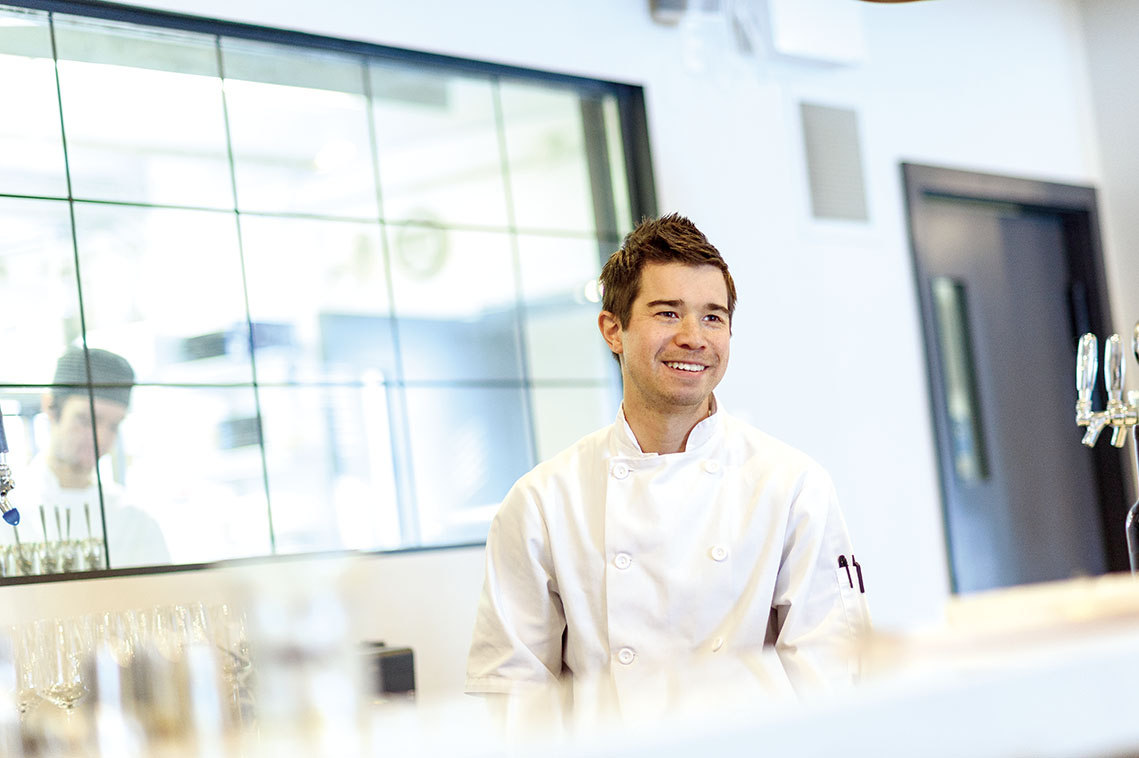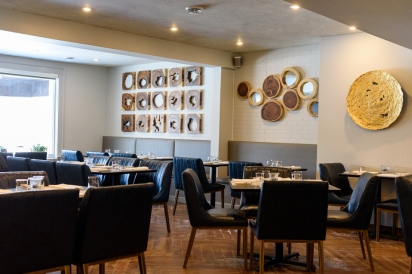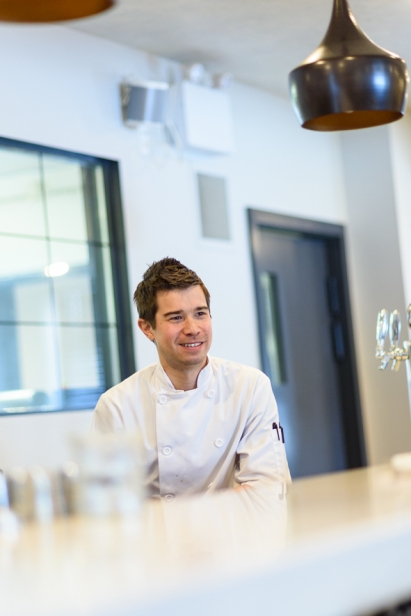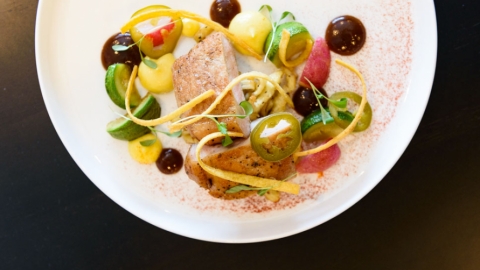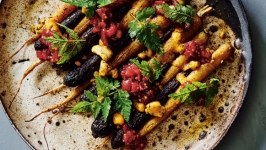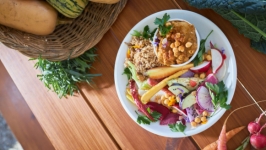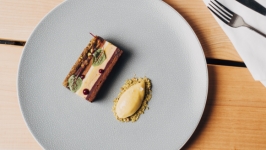Expect the Unexpected
To dine at Stofa is to be wowed by a kitchen’s creativity, but it’s hard to put into words exactly what the restaurant does that makes your meal so special. Inventive? Original? Surprising? These words all come to mind, but owner and chef Jason Sawision sums it up best.
“I think what we do is pull from a number of cuisines and that becomes our take on Canadian contemporary,” Sawison says of his restaurant, which is named for a Norse word that denotes a hearth or cast-iron stove around which people gather. “We’re trying to remove borders by bringing different cuisine types together. That’s how we innovate here.”
Asked to make a dish that speaks to his culinary philosophy or tells his story in some way, he chose sous-vide pork with a tamarind sauce, corn purée, spaetzle, fried tortillas, Himalayan squash, roasted radish, microgreens and pickled jalapeños.
It’s a perfect example of what Stofa does. The plump, chewy spaetzle is German, but the tangy tamarind sauce has East Indian roots. Latin American flavours round things out with big dots of sweet corn purée, strips of fried tortilla and sliced jalapeño, which lends a perfect punch. He seasons the pork with salt and pepper, cooks it sous-vide, and finishes it to crusty perfection in a cast-iron pan. The dish is festive in appearance — pink radish, green squash, yellow corn, all with a dusting of paprika over top to pull it together visually.
A unique culinary philosophy
Rather than thinking about traditional cuisines or ingredients, Sawision and his team think about flavour profiles.
“We’re trying to think of ingredients more broadly for what their uses are, rather than what [cooks] have always done,” he says. “I think that’s become our brand; we hear it a lot from our customer base.”
He aims to make Stofa’s dishes approachable, but unique at the same time.
“There might be strange combinations, but they work,” he says with a smile. “Our goal is to not make stuff that’s crazy and hard to comprehend on the plate, but we do try to make it as interesting as we can and provide combinations of flavours that might surprise our customers.”
Case in point is a raw tuna dish that was on the menu last summer and into the autumn. A slather of Thai green curry coated the bottom of the plate. Large chunks of tuna sat on top of it, along with a savoury lychee gel, but the garnishes were more Japanese — seaweed and pickled ginger, for example. And giving the dish height and crunch were long skinny slices of crispy burdock, an ingredient that is uncommon at best, and usually used in braised dishes or soups.
The menu at Stofa
Sawision changes his menu frequently, but doesn’t buy into full menu changes. Rather, he rotates dishes in and out.
“We like to think of our menu as always evolving, with different ingredients or with something new that we want to work with,” he says. “We do cook seasonally, I suppose, because that’s what’s available, but that’s not our framework or guide. Seasonal doesn’t dictate what goes on the menu.”
Interesting ingredients are really what excite Sawision. His sous-chef and chef-de-partie are both motivated by the same love of unusual fare, which provides the baseline for culinary adventures at Stofa.
“New ingredients fuel our creativity,” he says.
In another twist, the restaurant has two wines on tap, something seen in bigger centres, but a rarity for Ottawa. Sitting next to the beer tap, the two when we visited were Creekside Chardonnay and Creekside Cabernet-Merlot. Customers like the novelty of wine from a keg, he says, and it’s great for the restaurant because unlike bottles, once they tap a keg, it’s still good for six months.
A mix of culinary influences
Sawision, 37, who opened Stofa 17 months ago, also draws from his varied culinary path. Most recently, he was chefde- cuisine at Atelier, Marc Lepine’s cutting-edge, 12-table molecular gastronomy restaurant near Little Italy.
At Atelier, Lepine taught him plenty of molecular techniques, and he incorporates them into his creations at Stofa, but he uses his knowledge more for technique than for the “wow” factor.
Sawision had a very different experience when he worked at Eigensinn Farm, Michael Stadtlander’s French-inspired truly farm-to-table restaurant. Sawision worked there for more than a year, and that experience also figures into Stofa’s personality.
“When I first set out to do the restaurant, I wanted to blend these two very different styles of cooking,” he says. “Somewhere in the middle is where we are. We’re using a lot of techniques that are very modern, but we’re also using super-traditional comfort foods like spaetzle.”
Life on the farm
Eigensinn taught him a lot about “where the food comes from,” he says. He planted seeds in the extensive garden, raised and cared for the livestock, and then, when the time came, butchered them.
“You learn a lot about the ingredients and treating them properly because your restaurant depends on it,” he says. “It was very simple cooking, but, at the same time, it was extremely complicated because you’re having to make these ingredients shine. You want to showcase them as best you can.”
At Eigensinn, they grilled all of the meats over an open fire. And as a nod to that, they grill their meats at Stofa on a small, charcoal grill from Japan. The Malaysian charcoal they use means the smoke point is low while the heat is high. And nothing cooks for too long because most of the meat at Stofa is done sous-vide and just finished on the grill. When appropriate, they’ll also finish meat in cast-iron pans.
The meat of the matter
Prior to his stint at Eigensinn, Sawision worked at The Healthy Butcher in downtown Toronto.
The philosophy at The Healthy Butcher was whole-animal butchery. He had to learn how to butcher the cow, but he also had to know every single cut because after it was butchered, he’d have to try to sell them all to the customers.
“We’d have to be educators on how to cook all of these cuts,” he says. “Most customers know striploin, ribeye, tenderloin and ground beef. You’d have to educate them on some of the smaller cuts.”
He spent a year working there, doing butchery exclusively,and says it was a great experience and a skill that many cooks today are lacking, but that’s because it’s hard to do wholeanimal butchery in a high-volume restaurant. When he opened Stofa, the plan was to eventually incorporate the concept into the restaurant, but so far, that remains on the to-do list.
Honing his fine dining chops
Before he went to The Healthy Butcher, Sawision worked at Toronto’s celebrated Canoe restaurant, as chef de partie and tournant, under executive chef Anthony Walsh. There, he learned about high-quality ingredients and how to treat them.
“I also learned a lot about the business side,” Sawision says. “There were about 90 seats in the dining room and then there was a bar area and a place for private functions. It was highquality cooking for high numbers with a big team and it was really well run.”
He says Canoe is still high on his list of best restaurants in Canada — certainly top five — and that it has what is likely the best view in Toronto as it looks out on the CN Tower, Rogers Centre and the island. He says they often kept the blinds down in the daytime because of the sun, but at sunset, the wait staff would simultaneously raise them in ceremonial fashion.
“It was pretty cool,” he says.
Early influences
Chef Sawision, who grew up in Scarborough, has a bachelor of commerce in hospitality from the University of Guelph and studied culinary arts at George Brown College. Beyond that, he had some early inspiration from both sides of his family. His mom is Chinese and emigrated to Canada at a young age; his dad is Ukrainian-Russian and was born in Canada. The two met in high school.
“We ate a fair amount of Chinese food [at home], but my mom cooked all styles,” Sawision says. “And I was exposed to Eastern European at my grandparents’ house.”
He remembers his mom’s cooking as being either Chinese, or “all about homey staples — shepherd’s pie and dishes like that.” As he got older, he started teaching himself about the Asian ingredients in the pantry.
“We always had preserved black beans and different spice combinations — star anise, licorice, fennel, coriander — in the pantry. Very Asian flavours. There was cilantro, oyster sauce, soy sauce, hoisin. That flavour profile came to me sooner than maybe many chefs and it comes through in a lot of what we cook.”
Work-life balance
Sawision’s restaurant was born just weeks after his first-born child, a daughter, who is now 18 months old. How does a busy home life work when he spends five long days and evenings at the restaurant?
“My wife does a great job and she’s the biggest supporter of me,” he says. “I’m very thankful and I think it’s a very special situation. It would be tough if both people weren’t on board with what’s happening here. I’m here all five nights. That might change if we expand and grow and I take on a more managerial role, but I don’t think it’ll change in the immediate future.”
His wife, Katie West, works for the federal government so he takes care of mornings with their daughter and ferries her to daycare. Mom picks her up and takes care of the evening routine at home.
Both he and his wife are from Toronto and his parents visit about once a month to spend time with their granddaughter.
Early accolades
Nearly two years after it opened, Stofa is settling in as a driveworthy destination for many, and a neighbourhood restaurant for even more. And, it’s charmed the local and national press.
It has received mentions in Chatelaine, Ottawa at Home, Ottawa Magazine, Ottawa Citizen, Kitchissippi Times and Capital Dining. It also appeared 91st on the Canada’s 100 Best Restaurants list for 2018, along with other Ottawa notables, including Atelier (40), Riviera (54), Fairouz (62) and North & Navy (74).
“I didn’t expect that at all,” Sawision says. “That was a really nice surprise.”
What will keep it going? Sawision is betting on that unique mix of comfort and surprise.
Stofa Restaurant
1356 Wellington St. W., Ottawa, Ont.
stofarestaurant.com | 613.722.6555 | @stofarestaurant


